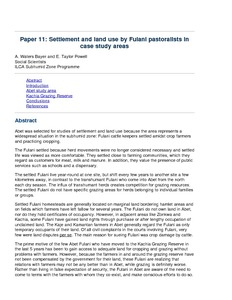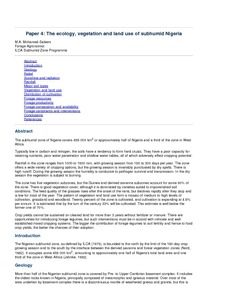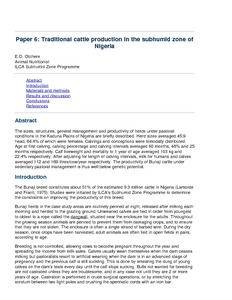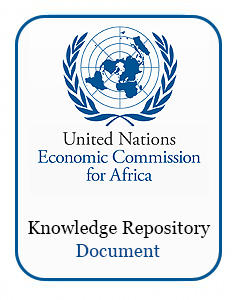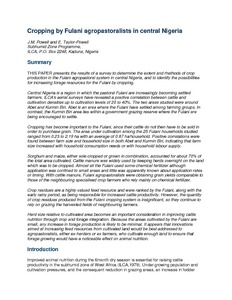Presents results of studies of settlement, land use & relations w. settled farmers of Fulani agropastoralists in Abet & Kachia Grazing Reserve in Subhumid Nigeria. Discusses reasons of choice of site, pattern & right of grazing and access to land.
Describes the geology, relief, climate, major soil types, vegetation zones and land use patterns of the subhumid zone of Nigeria. Presents results of studies on natural forage productivity & composition and forage production constraints.
Summarises the performance of three species of stylosanthes, viz, S. guianensis cvs Cook and Schofield, S. hamata cv. Verano and S. humilis under different production systems in Nigeria, such as in pure legume pastures, mixed pastures, with crops, in rangeland and under seed production.
Describes, briefly, sizes structures, general management and productivity of pastoral herds in the Kaduna Plains of Nigeria. Includes data on age at first calving, calving percentage, calving intervals, calf liveweight & mortality to 1 year, and milk yield of Bunaji cattle under this…
Nigeria has a land area of 925,768 km2 or approximately 92,4 million ha., which places her as the 14th largest country in Africa. With a population estimated at 80 million, every inhabitant theoretically has only 1.15 ha of land available for meeting basic economic, industrial and social needs.…
Attempts at settling or sedentarizing nomadic herders in semi-arid and arid regions have been largely unsuccessful, partly on account of the difficulty of restricting the movements of domestic livestock in areas where low and irregular rainfall lead to scant and unreliable sources of water and…
This paper is based on a series of studies conducted by the author on the settlement problems, work roles and educational experiments among nomadic Fulani in Plateau, Bauchi and Kaduna States, Nigeria, from 1982 to 1984.The first part of this paper describes the land tenure system in northern…
Examines the extent and methods of crop production in the Fulani agropastoral system in central Nigeria by analyzing cropping patterns, management techniques employed, and inputs to cropping such as labour, draught power & fertilizers, and output in terms of grain yield, energy and crop…
Examines the extent and methods of crop production in the Fulani agropastoral system in central Nigeria by analyzing cropping patterns, management techniques employed, and inputs to cropping such as labour, draught power & fertilizers, and output in terms of grain yield, energy and crop…
Shifting cultivation, under its diverse forms of slash and burn system, is a traditional method of cultivating tropical upland soils, mostly for subsistence purposes. This traditional system of cultivation is in ecological balance with the environment and does not irreversibly degrade the soil…


